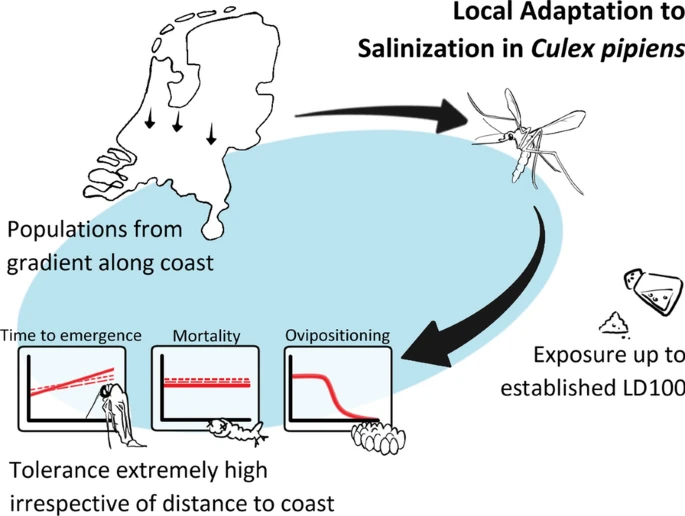Taking it with a grain of salt: tolerance to increasing salinization in Culex pipiens (Diptera: Culicidae) across a low-lying delta

This publication is part of the project ‘Preparing for vector-borne virus outbreaks in a changing world: a One Health Approach’ (NWA.1160.1S.210) which is (partly) financed by the Dutch Research Council (NWO).
Authors: Sam Philip Boerlijst, Antje van der Gaast, Lisa Maria Wilhelmina Adema, Roderick Wiebe Bouman, Eline Boelee, Peter Michiel van Bodegom & Maarten Schrama
Background
Salinity, exacerbated by rising sea levels, is a critical environmental cue affecting freshwater ecosystems. Predicting ecosystem structure in response to such changes and their implications for the geographical distribution of arthropod disease vectors requires further insights into the plasticity and adaptability of lower trophic level species in freshwater systems. Our study investigated whether populations of the mosquito Culex pipiens, typically considered sensitive to salt, have adapted due to gradual exposure.
Methods
Mesocosm experiments were conducted to evaluate responses in life history traits to increasing levels of salinity in three populations along a gradient perpendicular to the North Sea coast. Salt concentrations up to the brackish–marine transition zone (8 g/l chloride) were used, upon which no survival was expected. To determine how this process affects oviposition, a colonization experiment was performed by exposing the coastal population to the same concentrations.
Results
While concentrations up to the currently described median lethal dose (LD50) (4 g/l) were surprisingly favored during egg laying, even the treatment with the highest salt concentration was incidentally colonized. Differences in development rates among populations were observed, but the influence of salinity was evident only at 4 g/l and higher, resulting in only a 1-day delay. Mortality rates were lower than expected, reaching only 20% for coastal and inland populations and 41% for the intermediate population at the highest salinity. Sex ratios remained unaffected across the tested range.
Conclusions
The high tolerance to salinity for all key life history parameters across populations suggests that Cx. pipiens is unlikely to shift its distribution in the foreseeable future, with potential implications for the disease risk of associated pathogens.
Graphical Abstract

Read the whole publication here.